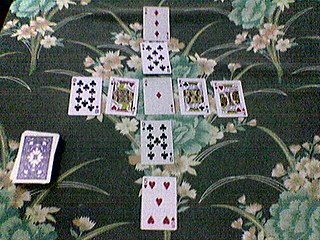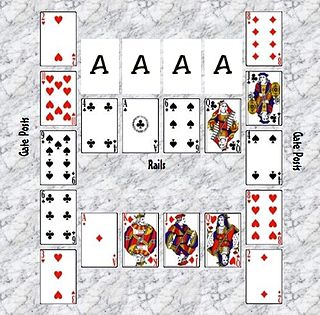
Games of patience, or (card) solitaires as they are usually called in North America, have their own 'language' of specialised terms such as "building down", "packing", "foundations", "talon" and "tableau". Once learnt they are helpful in describing, succinctly and accurately, how the games are played. Patience games are usually for a single player, although a small number have been designed for two and, in rare cases, three or even four players. They are games of skill or chance or a combination of the two. There are three classes of patience grouped by object.

Windmill is a solitaire card game played with two decks of playing cards; it is a relatively mechanical game that isn't won that frequently. It is so called because of its distinctive initial layout, which resembles a windmill's sails. It is also known under the name Propeller.
Sir Tommy, also called Old Patience, is a patience or solitaire card game using a single pack of 52 playing cards. It is said to be the ancestor of all patiences, hence its alternative title. It is a half-open, planner type of patience game in the same family of card-building games as Calculation and Strategy. It is also known as Try Again and Numerica.
Royal Rendezvous is a solitaire card game which uses two decks of playing cards shuffled together. It is also known as Royal Appointment.

Diplomat is a patience or solitaire card game which is played using two decks of playing cards shuffled together. Its layout is similar to that of Beleaguered Castle, and the play is similar to Forty Thieves. It can be completed successfully more often than not.
Queen of Italy is a solitaire card game played with two decks of playing cards. It is a very strategic game that rewards careful planning, since the cards that potentially block the game are presented at the start, and with care it can be completed about half the number of attempts.
Duchess or Glenwood is a patience or solitaire card game which uses a deck of 52 playing cards. It has all four typical features of a traditional patience or solitaire game: a tableau, a reserve, a stock or talon and a wastepile. It is relatively easy to get out. It is a reserved packer, the same type of game as Canfield or Demon. Arnold describes it as "an interesting game with a fair chance of a favourable outcome."

Colorado is a solitaire card game which is played using two decks of playing cards. It is a game of card building which belongs to the same family as games like Sir Tommy, Strategy, and Calculation. It is considered an easy game with 80% odds of being completed successfully.

Alhambra is a solitaire card game which is played using two decks of playing cards. Its unusual feature is akin to that of Crazy Quilt: the cards in the reserve are built either on the foundations or on a waste pile.

Queen's Audience, sometimes known as King's Audience, is a pictorial patience or solitaire card game which uses a single pack of 52 playing cards. It is so named because the Jacks and their 'entourage' end up adjacent to their respective Queens as if having an audience with them.
Odd and Even is a solitaire card game which is played with two decks of playing cards. It is so called because the building is done in twos, resulting in odd and even numbers.
The Plot is a Patience game which is played with two decks of playing cards.

Four Seasons is a patience or card solitaire which is played with a single deck of playing cards. It is also known as Corner Card and Vanishing Cross, due to the arrangement of the foundations and the tableau respectively. Another alternate name is Cross Currents.

Fortune's Favor or Fortune's Favour is a patience or card solitaire which is played with a deck of 52 playing cards. It is so-called probably because the chances of winning are completely on the player's side. It is a significantly simplified version of the game Busy Aces, a member of the Forty Thieves family of solitaire games.
Patriarchs is a patience or card solitaire which is played with two packs of playing cards. It is similar in reserve layout to Odd and Even but with different rules of play.
Contradance is a solitaire card game which is played with two decks of playing cards. It is probably so called because when the game is won, it shows the king and the queen of each suit about to do a dance, the cotillion being a country dance from the 18th century.
Frog is an old French patience or solitaire card game which is played with two decks of playing cards. It belongs to the same family of solitaire games as Strategy, Sir Tommy, Calculation, and Puss in the Corner. Game-play is like Sir Tommy, but with two decks, a fifth waste pile, and a Canfield-like reserve. In its native France it is known as Le Crapaud.
Zodiac is a solitaire card game which is played with two decks of playing cards shuffled together. An old game, it first appeared in Lady Adelaide Cadogan's book Illustrated Games of Patience. It is so-named probably because of its "globe"-shaped layout. It had many variations until its rules were standardized in 1914.

Gate is a solitaire card game played using a deck of 52 playing cards, and is a member of the Canfield family. It gets its name because the cards are laid out in such a way that they form a gate. Average players can expect to win 99% of their games.
Jubilee is the name given to two solitaire card games, both played with two decks of playing cards. Both games are so-called because they were created during the time of the Golden Jubilee of Queen Victoria in 1887. One of the games has an ornate layout, while the other is simpler and it belongs to the family of games which include Sir Tommy, Strategy, and Calculation.










